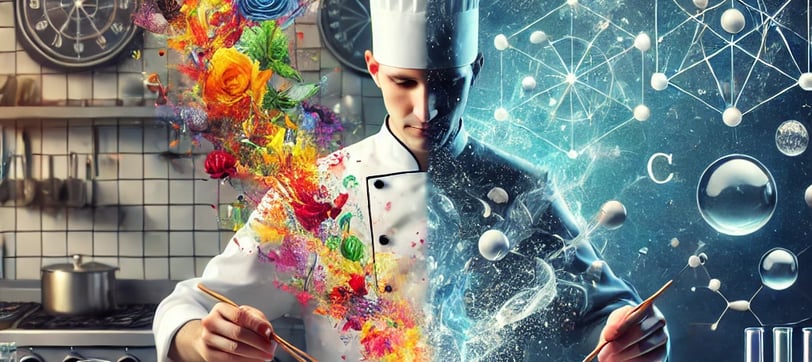Body and Mind: The Art and Science of Cooking


I love cooking. The simple truth is that even though I have many interests, if I could only pursue one of them, it would be cooking. Cooking is more than just a means of ensuring nourishment and survival—it is in fact a profound combination of creativity and calculation, an exquisite blend of art and science that nourishes both the body and the mind. From understanding complex chemical reactions to the artistic presentation of a plated dish, cooking engages both the rigor of science and the wonder of imagination - making it a uniquely fulfilling human endeavor.
At its core, cooking is a scientific process. It relies on chemical reactions, precise measurements, and an understanding of how ingredients interact under various conditions. The Maillard reaction, for example, is a fundamental scientific principle in cooking that gives grilled meats their rich, brown crust and enhances flavor complexity. Similarly, the process of emulsification in sauces, the role of yeast in bread fermentation, and the temperature control needed to temper chocolate all stem from scientific principles.
The science of cooking extends beyond chemistry into biology and nutrition. Cooking transforms raw ingredients into digestible, nutrient-rich meals that fuel our bodies. Understanding the macronutrient balance of proteins, fats, and carbohydrates allows both chefs and home cooks alike to create meals that are not only delicious but also nourishing. Precision in cooking techniques, such as sous vide or molecular gastronomy, pushes the boundaries of culinary science, turning cooking into an experiment where exact temperatures and times hopefully lead to perfect textures and flavors.
While science provides the foundation for successful cooking, art is what brings food to life. The act of cooking is a deeply expressive form of creativity, where flavors, colors, and textures come together to create an experience that delights the senses. A chef, like a painter, carefully selects ingredients as if choosing colors from a palette. The plating of a dish, the balance of flavors, and the presentation are all artistic choices that can, when done right, elevate a meal from mere sustenance to a sensory masterpiece.
Cooking also carries cultural and emotional significance, much like art. Different cuisines reflect the history, geography, and traditions of a region, telling stories through flavors and techniques. A dish can evoke nostalgia, celebrate heritage, or even challenge culinary conventions through fusion and innovation. Cooking is, in essence, a performance—one where the creator orchestrates aromas, textures, and tastes to evoke emotions in those who are lucky enough to partake in the meal.
Indeed, cooking is not just about fueling the body; it also enriches the mind. The act of cooking engages problem-solving skills, enhances patience, and fosters creativity. Experimenting with new recipes, adjusting flavors, and improvising with ingredients stimulate cognitive functions. The process of preparing and sharing food also strengthens social bonds, bringing people together over a joyfully shared experience.
Additionally, the mindful practice of cooking can be therapeutic. The rhythmic chopping of vegetables, the soothing aroma of baking bread, and the satisfaction of creating something from scratch provide a sense of accomplishment and relaxation. At its most basic, cooking is a meditative art form, encouraging mindfulness (watch that knife!) while engaging in an activity that is both practical and fulfilling.
Cooking is the perfect blend of art and science, a discipline that satisfies the body while engaging the mind. It relies on the precision of chemistry and physics while embracing the boundless creativity of artistic expression. Whether through meticulous technique or intuitive improvisation, cooking remains one of the most profound and universal ways humans connect with their world, their culture, and each other.
So, let's get cooking!
Contact
Subscribe to my eNewsletter
© 2024. All rights reserved.
kellycunningham1021@gmail.com
